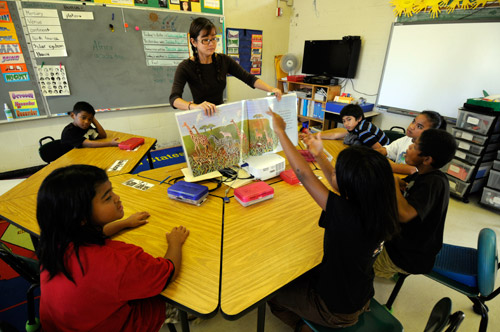School set to begin major turnaround

Lisha Collier, assistant teacher for fourth- and fifth-graders, reads a book with her students at Hawaii School for the Deaf and the Blind. The institution, named a "priority school" in the state's successful Race to the Top proposal, will undergo an assessment this week as part of a project to improve student performance, parent involvement and the number of highly qualified teachers.
A team of local educators and two mainland consultants will conduct a "comprehensive needs assessment" at the Hawaii School for the Deaf and the Blind this week, kicking off a project to boost student achievement, foster parent involvement and increase the number of highly qualified teachers at the state’s last special education-only campus.
The school is one of six "priority" schools identified in the state’s Race to the Top proposal as in need of a turnaround, but it’s not yet clear what that turnaround will look like for a school with so many unique challenges.
Many of the school’s 77 students — 20 of whom are from the neighbor islands — are behind because they come from hearing homes where no one speaks American Sign Language.
In some cases, their parents don’t speak ASL or English.
The school also has students who are developmentally delayed and those who have struggled to learn through interpreters in their neighborhood schools, coming to the Kapahulu campus after making little progress for years.
In addition, about 60 percent of students at the school are from low-income families.
Don't miss out on what's happening!
Stay in touch with breaking news, as it happens, conveniently in your email inbox. It's FREE!
"Our students come to us with very minimal exposure to sign language," said Sydney Dickerson, HSDB principal. "We’re always playing catch-up. We’re even getting them when they’re in the double digits, not knowing English, not knowing ASL."
HAWAII SCHOOL FOR THE DEAF AND THE BLINDEstablished in 1914 » Student population: 77 students in pre-K through 12th grade » Percent of children who get free or reduced-cost lunch: 60 percent » Percent of students with limited English proficiency: 41 percent Source: State Department of Education
|
Like many schools for the deaf nationally, HSDB hasn’t met adequate yearly progress goals for student math and reading proficiency under the federal No Child Left Behind law.
The school also lacks highly qualified teachers (those who have completed their licensure and competency test requirements). Only one of the school’s 10 teachers in core areas is highly qualified.
Dickerson said the school will never meet the benchmarks for student performance under NCLB, which by 2014 will require 100 percent of students to be proficient in reading and math.
But she said the school has been making gains — slowly nudging up test scores — and is looking to make more improvements.
"We haven’t just been sitting around saying, ‘Boo hoo, we haven’t been making AYP,’" Dickerson said. She added, "We need to be held accountable" for making progress.
In testing earlier this year of third- through eighth-graders and 10th-graders at HSDB, one sophomore neared proficiency in reading.
The rest of the school’s students were below or well below.
In math, a handful of students neared proficiency on some subtests.
And several students neared proficiency in science, with one meeting proficiency in a life science section.
"They’re moving in the right direction," Dickerson said.
AS PART OF its $75 million Race to the Top grant, which the state was awarded last month, the Department of Education is targeting six struggling "priority schools" in need of major assistance to improve student achievement, graduation rates and test scores.
HSDB is the only priority school in urban Honolulu (the others are on the Leeward Coast and the Big Island), and given its special population its path to improvement will look different from those for other campuses. In its Race to the Top plan, the state says HSDB will "require intervention and support that is unique in the school system and in the state."
The Race plan doesn’t lay out what the school’s turnaround will entail, but officials say the first step is the needs assessment. The team visiting the school plans to identify what the school is doing right, where its weaknesses are and what strategies will help address problem areas.
DOE school improvement specialist Geriann Hong said HSDB will use the needs assessment to "see how they can revive their (strategic) plan so that it’s targeted" to tackle concerns.
The team will be evaluating everything from classroom organization to the school’s financials to initiatives to boost parent involvement.
Principal Dickerson said the school is already trying to improve in those areas.
HSDB has been bringing in new curricula, including one that stresses literacy. And it plans to work with students to shoot and edit a promotional video about the school, teaching them hands-on skills while also producing something designed to give the community more information about the campus.
Stacey Buther, who teaches fourth and fifth grade at HSDB, said there is a lot to celebrate at the school — small successes she sees every day.
Her students, she said, are eager to learn. But they also often start school behind, sometimes never learning to sign at home. (With their parents, they use rudimentary hand gestures.)
"My charge is to teach them (sign language), expose them to a lot of vocabulary at the same time that I’m educating them" in other subjects, said Buther, speaking through a sign language interpreter.
Of her seven students, two sign age-appropriately.




